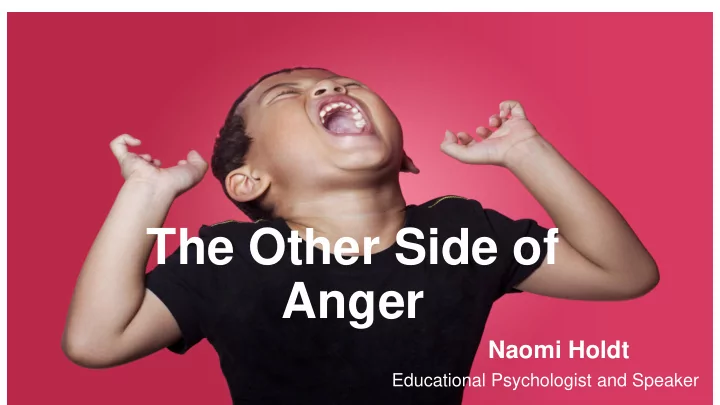

The Other Side of Anger Naomi Holdt Educational Psychologist and Speaker
Aim of this talk
Our angry world
. Understanding Anger
Understanding First
What is ANGER?
• An emotion characterized by antagonism toward someone or something you feel has deliberately done you wrong. (American Psychological Association) • Emotional response indicating a person has experienced a perceived injustice • Emotional response produced as a result of the emotional space we are in and our thinking • Normal • Common • NOT: • An action • Something we outgrow • Automatic reflex • Caused by others
What’s happening in the brain?
What’s happening in the body?
Genetics?
MAOA and CDH13
Some studies: • Child Abuse • Intoxicants • High levels of Testosterone (fetal and young child)
Epigenetics
. Why are children so angry?
The impact of our society • Aggression and violence everywhere • Role models reinforce • Normalizes anger responses • Desensitizes children to the horror of violence and increased tolerance develops • Children take on a fearful view of the world
The impact of screens • 6-7 hours per day (8-18 years) • Gaming impact (FFF activated) • Violent games e.g. Grand Theft Auto • Todays children are exposed to close up violence- perp stabbed, shot multiple times • One study showed 40% violence committed by ‘good guys’ - Interpretation- ‘good guys’ are violent • For every hour TV a 4 year old watches daily, risk becoming a bully increases between age 6-11 by 6-9%. • Girls aged 6-10, watching programmes with aggressive protagonists, are more likely to turn into angry adults
. Anger from all sides
The downside of anger
Misunderstood Emotion
The upside of Anger “Anger is a powerful and healthy force in your life. You NEED to feel it” Ryan Martin
The upside of anger
Ryan Martin- Anger researcher
Triggers • Not an event • Emotional space we are in • THAT is role of therapist, educator, parent- to understand the emotional space the child is in in order to help them change it • When emotions are not reflected and understood= (onion)- leads to anger • In situation- child may not have the skills to accomplish task- so feels insecure. Incompetency is highlighted- Consider primary emotion?
What happens to unprocessed anger?
Long term health impact (high cortisol levels)
The wisdom of Shrek
The Onion Emotion
Further considerations • Depression • Obsessive Compulsive Disorder • ADHD • Oppositional Defiance Disorder • Sensory Integration Disorders • Autism • Early-onset Bipolar Mood Disorder • Intermittent Explosive Disorder • Temporal and Frontal Lobe Epilepsy • Reactive Attachment Disorder • Learning Disorders • Grief • Trauma • Brain damage injury
Helping the Family .
Thriving Anger: The perfect recipe
Most essential tool for helping the family
Index patient?
Teaching & Talking about Emotions
Extending Emotional Vocabulary
. Helping the angry child
Setting free the forbidden ‘A’ word
Identifying the angry child
When is anger a problem? • Too frequent • Too intense • Lasts too long • Masks other emotions • Disturbs family/ peer relationships • Hurts people • Harm to animals • Self harm • Explosive outbursts
Assessing Anger • Drawings and play- consistent theme • Behaviour towards others • Repeated aggressive actions/outbursts • Meltdowns/ tantrums beyond developmental age (7/8 years old) • Severity impacts on family • Impact on academic/ classroom functioning • Isolation from peers?
Processing Emotions
Getting to the root- Peeling the layers Our response to charged emotions should be to assess primary emotion
Assess the primary emotion first
The porcupine effect
Role of Educator .
Role of Educator • Recognise • Normalise • Support parents • Role model • Be proactive • Respond unemotionally • Teach problem solving skills • Notice the positive • Never meet anger with anger • Refer for therapeutic assistance if necessary
Role of the Therapist .
NOT begin with change • Begin with understanding
Mindfulness practices
CBT: Changing the soil
Problem solving
Empathy
Looking through the glasses
Retrain the brain
Gratitude
Loving through the quills Breaking the cycle of rejection
Recommend
More recommend